Solar Flares and the Sun's influence on our climate are the burning issues of this week's show. We discover an explosion on the Sun so large that it cut global communications all over the world and rendered compasses useless. Also, we'll be looking at the link between the sun and climate change and finding out how clouds could predict earthquakes. Plus, in this week's news, we discover why some balls are really hard to catch we talk about the seahorses returning to the Thames. And in Kitchen Science, Dave shows us how to light a bulb without wires - using only a balloon! All this and more on The (naked) Science of the Sun...
In this episode
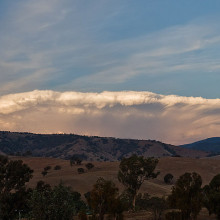
Could seismic events shake up clouds?
Scientists in China are investigating the possibility that seismic events might trigger the creation of strange cloud formations.
 Writing in the International Journal of Remote Sensing, Chinese scientists Guangmeng Guo and Bin Wang from Nanyang Normal University in Henan report that about 60 days before each of the two magnitude 6 earthquakes that struck Iran in 2004 and 2005 respectively, a gap hundreds of kilometres long appeared in the clouds over the main fault in the south of the country. The gap remained in place, despite the surrounding clouds all moving, and thermal images showed that the ground around the fault was warmer than the surrounding areas. The Chinese researchers suggest that hot gases escaping from the active fault could have caused water in the overlying clouds to evaporate.
Writing in the International Journal of Remote Sensing, Chinese scientists Guangmeng Guo and Bin Wang from Nanyang Normal University in Henan report that about 60 days before each of the two magnitude 6 earthquakes that struck Iran in 2004 and 2005 respectively, a gap hundreds of kilometres long appeared in the clouds over the main fault in the south of the country. The gap remained in place, despite the surrounding clouds all moving, and thermal images showed that the ground around the fault was warmer than the surrounding areas. The Chinese researchers suggest that hot gases escaping from the active fault could have caused water in the overlying clouds to evaporate.
An alternative theory is that ions created by rocks being squeezed together, as was shown recently by researchers at the NASA Ames Research Center in California, could have altered conditions locally, causing the clouds to dissipate. This is not the first time that curious cloud cofigurations have been linked to seismic activity - the authors point to research carried out by Russian scientists in the 1980s who also recorded thermal and cloud anomalies before an earthquake, although no further results have been forthcoming, so it could, quite literally, amount to nothing but a load of hot air.
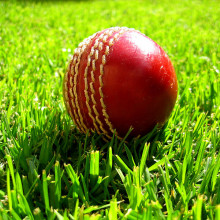
06:43 - Bend it like Beckham: why "easy" balls are so hard to catch
Bend it like Beckham: why "easy" balls are so hard to catch
Crowds at cricket and baseball games often stare increduously as fielders fumble what was, at first glance, a dead easy catch: the ball was chipped straight up in the air off the bat, and it should just be a case of putting yourself beneath it surely?
Not so, say US researchers Alan Nathan and Terry Bahill, who have modelled the trajectories of balls like these and published, in this month's American Journal of Physics, why they're so hard to catch.
The reason is that most "pop-up balls" as they're known have enormous amounts of backspin, and this causes the ball to move in a difficult-to-predict manner, because as it spins it drags a sheath of air with it, which causes the ball to follow a curved course.
That doesn't sound too bad, but the effect, known as the Magnus Force (after the German scientist Heinrich Gustav Magnus who studied the aerodynamics of spinning cylinders and spheres in the 1850s) is not constant throughout the ball's flight.
When the ball travels fast, the air finds it hard to stick to the surface so the Magnus effect is minimal.
But as the ball slows down, and a layer of air sticks to it, the bending effect becomes highly pronounced, and the ball can change direction quite suddenly.
To find out whether they were on the right track the researchers ran computer simulations of how a player might react to balls displaying these behaviours.
They found that their results were a close match with the indecisive dance exhibited by players attempting to catch balls like these.
The findings agree with previous studies of footballers facing corner kicks from the likes of David Beckham and Wayne Rooney.
Spinning balls behave identically under these circumstances and are equally hard for goalkeepers to save.
The reason, scientists think, is that although the human brain has evolved very well to anticipate the effects of gravity, because spinning objects are unusual in nature, we have limited cognitive abilities to compensate for them.
And who'd have though David Beckham or Wayne Rooney were physics geniuses to boot...?
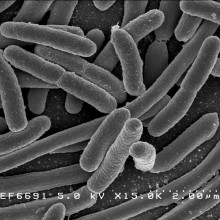
Pesticide blasting bacteria
Researchers this week have revealed a new way of using bacteria to help mop up harmful chemicals in the environment like pesticides.
 Using microorganisms to help clean up the environment, so called bioremediation, is an idea that's been around for a while - for example to help mop up oil spills.
Using microorganisms to help clean up the environment, so called bioremediation, is an idea that's been around for a while - for example to help mop up oil spills.
Now a team of scientists from Emory University in Atlanta in the US led by Justin Gallivan have genetically engineered E. coli bacteria - that common bug that lives in our gut - so they can detect particular harmful chemicals, swim towards them and gobble them up.
Naturally, these bacteria have receptors on their cell surfaces that detect chemicals of interest to them in the environment, often some sort of food. The chemical triggers a chain of events that activates a tiny whip-like hair called a flagellum that whizzes round and pushes the bacteria forwards towards the source of the chemical.
What the team did was knock out the gene in E. coli that makes them move forwards and added in a segment of RNA, called riboswitch which responds to the presence of a particular pesticide called atrazine. When the switch detects atrazine it turns on and the flagellum and the bacteria moves forwards towards higher concentrations of the chemical - when they reach the atrazine, they metabolise and turn it into harmless waste products.
There are some draw backs of using riboswitches outside Petri dishes. It's possible that at the moment the bacteria might not be sensitive enough to the low concentrations of chemicals in contaminated soils.
But there are a number of advantages too mainly that searching for these riboswitches in the lab is much quicker than other methods like trying to change existing receptors to be sensitive to the chemical you are interested in. And it is also possible to make riboswitches sensitive to only very specific molecules so they could be designed to deal with all sorts of different pollutants.
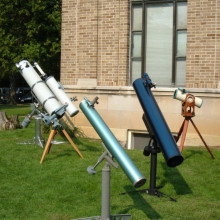
15:22 - Amateur Astronomers Assist Experts
Amateur Astronomers Assist Experts
with Dr Pamela Gay, Southern Illinois University
Chris - Here's a question: The universe is a big place and if you only have a small number of telescopes with which to look at it, and limited resources to analyse the data that you collect, inevitably lots of important questions will go unanswered. So how do you solve that problem? The answer is by professional astronomers teaming up with amateurs around the world and asking them to do some of the observing.
And that's exactly what Dr Pamela Gay from the Southern Illinois University, Edwardsville has been doing...
Pamela - I work with the American Association of Variable Star Observers which, while it has the name America in its title, is actually an international organisation of observers. We have people from all around the world. Amateurs who liked to go out in their back yard and look at stars and measure how bright they are. It sounds like just a fun game but for scientists this is amazingly powerful. I study a type of star called RR Lyraes. These are stars about 26 times the mass of the sun. They aren't stable and they get larger and smaller. They change in brightness as they do this. When Shakespeare said inconstant stars he was exactly right, they are inconstant. They do this over less than a day ad to fully understand them I actually need about a month's worth of data because the night is short and I can't always get the entire light curve; the entire change in brightness from light to faint.
Chris - Is that because there's competition for the telescope time so you can't literally hog it for that long to see the full periodicity of what these stars are doing?
Pamela - I can often hog it for one night but then the sun comes up before I'm done. If I can get, say, the first 60% of one light curve one night I might be able to get another 3% to 63%. I have to go there night after night for the star to cycle all the way around. They're not going to give me ten nights. If I observe in the United States and I can find an Italian astronomer with a telescope in his back yard to observe from there and I can find an Australian in his back yard (I'm sure it's far enough south that the Australian can see it) my star can get handed off around the globe from person to person.
Chris - So what's the idea here? You will recruit people who are doing astronomy as a hobby and get them into your project so they're contributing to your research?
 Pamela - Exactly. This is an opportunity for someone to take their hobby, their love of going outside and watching the stars and how they change, and actually contributing to our knowledge of how the universe works. The particular stars I'm working on aren't well understood and until we can observe probably about 100 of them in deep detail we can't make heads nor tails of them. We just know their behaving oddly.
Pamela - Exactly. This is an opportunity for someone to take their hobby, their love of going outside and watching the stars and how they change, and actually contributing to our knowledge of how the universe works. The particular stars I'm working on aren't well understood and until we can observe probably about 100 of them in deep detail we can't make heads nor tails of them. We just know their behaving oddly.
Chris - What are you asking these people to do and how do you know you can trust their data? As a scientist myself I'm a total perfectionist and unless I've done it myself I get terribly worried that it's not trustworthy. How do you get trustworthy data out of people you've never met?
Pamela - The trick is that you have to calibrate things in multiple directions. If I have a field of stars (and they can take a visual picture and capture four stars in it) one of them's my target star that's changing in brightness all the time. The other three are constants and if I know those other stars have values of 10, 10.4 and 11.
Chris - This is the brightness?
Pamela - This is the brightness. We measure brightnesses on a scale of 0 to as dark as it gets. 0's the brightest, the human eye cuts out about 6. You can get with a typical backyard telescope down to about 14 and the numbers just keep getting bigger. If I know for certain the numbers associated with three of the stars and I know the fourth one varies and their measurements of those three are bang-on the same the entire time I know I can trust the results.
Chris - You're asking people to send you pictures or just brightness measures of the same stars which you can then calibrate to use their results?
Pamela - What I asked them to do was take the images and make the measurements of this one is 10, this one is 11 and this is what your variable star is and just send me an Excel spreadsheet. Then I combine all these Excel spreadsheets. A couple of years ago I did a campaign. I got, in three months, over 8000 observations. They weren't all perfect but out of those 8000 data points I got several thousand that allowed me to solve a problem star that I'd been struggling with since 1992.
Chris - This is the astronomy equivalent of the CETI experiment where you're just analysing huge amounts of data that professionals couldn't have the time to trawl through. So you get people to just do something for you?
 Pamela - This actually takes that model and turns it on its head. With CETI at home; with Galaxy Zoo the scientists are acquiring all the data and then with CETI they're saying please let me abuse your CPU processor on your computer and it will tell me the analysis. With Galaxy Zoo they're saying, "we have all these pictures please can you do the analysis for me?" In my case I'm going, "I want to do the analysis but I don't have the data!" I'm asking them, " can you please use your telescopes to get me the data I need."
Pamela - This actually takes that model and turns it on its head. With CETI at home; with Galaxy Zoo the scientists are acquiring all the data and then with CETI they're saying please let me abuse your CPU processor on your computer and it will tell me the analysis. With Galaxy Zoo they're saying, "we have all these pictures please can you do the analysis for me?" In my case I'm going, "I want to do the analysis but I don't have the data!" I'm asking them, " can you please use your telescopes to get me the data I need."
Chris - Astronomer, Pamela Gay explaining how amateur astronomers can team up with professionals to do cutting-edge research. She was in Cambridge this week to take part in a meeting between the AAVSO (American Association of Variable Star Observers) and their UK counterparts, the British Astronomical Association. As luck would have it, I also managed to track down one of those amateur astronomers who's been helping Pamela with her research. I found him in the Castle pub.
Jerry - My name is Jerry Samolik, I live in Greenfield, Wisconsin, USA. My interest in astronomy probably started late 50s, early 60s with the beginning of the space programme. I still have an article in a magazine called Space Journal 1958 covering the launch of the first American Satellite. I guess I've been a fanatic since childhood!
Chris - You're just really interested in Astronomy and Space Science, you're not a professional but you do do a lot of this stuff.
Jerry - Correct. By profession I'm an engineer. I've been observing since I was in high school. In my back yard I've got one flip-top observatory with a 10" LX-200 ccd camera. The entire building is 3 feet by 4 feet so I can't get inside of it. It's just big enough to house the telescope. Once I get the thing sorted I set the autoguider up and I go to bed.
Chris - How many people in America and elsewhere in the world do you know of through your connections that do similar things to you, that are doing pretty high level astronomy but from the home?
Jerry - Well, a number of people is hard to count. We have three active observers in Italy, we have several in the United States - maybe half a dozen. We have one in Australia and what we try to do is coordinate our efforts. The Italian observer will get on a star. He'll send me an email that's still new in my time. He's telling me what he's observing so I can set up a target that evening. As the Earth rotates I'll carry the star across. For summer stars sometimes we can pass them along to Neil Butterworth in Australia so that we can get more than half a revolution of the planet and target it.
Chris - You're doing pretty high-level work. Do you struggle to get professionals to take you seriously though?
Jerry - I don't think so. The organisation I belong to, the AAVSO, has always been in very high regard of the professionals. It's always interesting going to the meetings because we'll have amateurs giving programmes and professionals listening to them.
Chris - So what are you looking at the moment?
Jerry - This time of year I'm working on a few RR Lyrae stars. I've got one I'm working on in Cancer. I'm just picking up on one area of Hercules that's just starting to come up in the evening that I can run throughout the night. That's been a star I've been observing visually probably since the 1980s. It's got a very interesting dual mode that pulsates. We've got kind of a handle on it but every so often I see something out of the ordinary and I'm just trying to see if that happens again.
Chris - That was Jerry Samolik explaining how amateur astronomers like him can make powerful contributions to science just by helping professionals with their observations. Pamela Gay who you heard before that was telling me that if you'd like to find out a bit more about the AAVSO, that was the body that he was a member of, then you can get involved with them. Their website address is AAVSO.org.
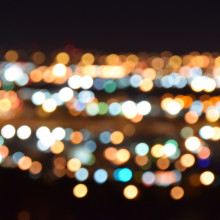
How does a white surface reflect light?
Chris Smith answered this question...
Well, if you think about what light is, light's a wave: it's an electromagnetic wave, which wiggles its way through the atmosphere and through space.
When it hits something transparent, the wave hits that substance and it goes through it. As it goes through it, the wiggling of the wave makes the particles in that substance wiggle as well. That includes the electrons. If the substance is transparent, the wiggling of the electrons regenerates the wave as the light goes through the substance, albeit with a time delay, which is why the light slows down a bit on its way through. When it comes out the other side, it's recreated again with no loss of energy.
What about if the substance isn't transparent, in other words, if it's opaque?
Well, of course it reflects light and that gives it its colour. If it reflects no light, it's black.
We recently featured on this show the darkest substance in the Guinness Book of Records ever. Pulickel Ajayan produced this substance. He's at Rensselaer Polytechnic.
The way he did that was by producing these nano-tubes: a forest of bamboo-shaped nano-tubes. These are tiny skeleton tubes like straws of carbon. They're literally thousands of times thinner than a human hair. By making a sea of these things, when light goes down into this, ricochets off a nano-tube and bounces into another one it just gets lost. It gets trapped inside so nothing gets reflected. That makes the substance very, very dark.
When light gets soaked up by a substance, basically what's happening is that all the energy (the vibrations) of the light are making the atoms in that substance vibrate. So it's making heat. That's why solar cells that are made of black stuff get warm, because they're soaking up the light energy and radiating very little out.
When a substance is radiating other colours, what's happening is that some wavelengths of light - some wiggles - are absorbed and they turn into heat in that substance whilst others are reflected.
When they're reflected, basically the wiggle the wavelength imparts to the material creates another light wave of the wavelength of the colour that you see. That's why it reflects light of that particular colour. With white, the substance is very good at reflecting all wavelengths of light which is why - if you add all the wavelengths of light together - you see white. That's why it looks white.
That's why water is clear when you shine light into it but snow crystals are white, because with water light can pass straight through. With snow crystals light bounces around all over the place so all the light gets returned to you so it looks white.
Helen - So it's all about what different substances are made of and how they vibrate?
Chris - Yes, the different substances will soak up different light of different wavelengths, different frequencies but not others. Different colour lights have different frequencies to each other and some will be soaked up by the surface and others won't...
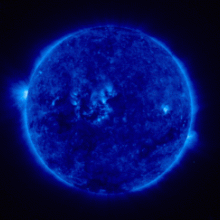
26:31 - The Science of Solar Flares
The Science of Solar Flares
with Stuart Clark and Chris Davis
You probably already know that the sun is, ultimately, the source of almost all life on Earth - but sometimes the Sun causes havok! Stuart Clarke is the author of "The Sun Kings" - The story of Richard Carrington and the Birth of modern astronomy, and he joins us in the studio now.
Carrington observed something now called the Carrington Flare in 1859 - but observations of the Sun have come a long way in those 150 years. Chris Davis from the Rutherford Appleton Laboratory joins us to tell us a bit more about how we study the Sun, including the innovative STEREO programme - using two spacecraft to get stereoscopic, so 3D, images of the Sun...
Chris - First of all, let me introduce you to Stuart. Hi Stuart. Thank you for coming in.
Stuart - It's my pleasure.
Chris - Tell us about this story. We view the sun as this highly predictable and stable thing. You get up in the morning and it's always there. The evidence is, it's not as stable as we might think.
Stuart - Indeed. The sun is a highly variable cauldron of the most intense magnetic activity. If you go back in history you can find times when there have been extraordinary events that have taken place on the sun via its magnetic field. The Sun Kings is about what appears to be the most violent of these storms in history. That took place on September the 2nd, 1859.
 Chris - What happened?
Chris - What happened?
Stuart - Well, imagine this: two thirds of the Earth's skies erupt with the most incandescent, blood-red aurora. The kind of things that you see in the sky usually when you go up to high polar latitudes.
Chris - So the whole sky just goes bright red like it's made of blood?
Stuart - In this case, yes. That's what most of the eye-witness reports suggest. Worse than that is there seem to be bolts of white light flaring upwards and exploding with silent brilliance in the heavens. It was just the most amazing cataclysm that engulfed most of the Earth's skies.
Chris - This was the 1800s. People must have thought the Earth was coming to an end?
Stuart - They had absolutely no idea what was going on, at all. There was a sinister side to this story as well. At the time that the aurora lit the sky the telegraph network across the world went down. It stopped functioning and it stopped functioning in the most spectacular of fashions. Electrical currents surged along the wires into the offices. The sparks flew from the equipment, offices were set on fire, some of the operators were stunned unconscious. The whole of the telecommunications network (as the telegraph was at the time) was taken down. At the same time, every compass on the Earth went haywire. In an instant and for reasons unknown to anybody global communications and navigations just stopped.
Chris - Did people have any clue as to what was going on? There must have been massive speculation. People must have thought, 'the end of the world is nigh,' here.
Stuart - One person was in the right place at the right time. The kind of coincidence you couldn't get away with writing in fiction. That person was an English amateur astronomer called Richard Carrington. He was working in his observatory at Redhill and he was engaged in his mission for a full 11 years and chart the comings and goings of dark blemishes on the surface of the sun, called sunspots. It was known that the more sunspots there were on the sun, the more unreliable the compass readings were. There was this clue that somehow the sun was magnetic and that magnetism could reach out across space and affect the Earth,
Chris - So how did Carrington connect this amazing event that you're describing with the sunspots that were going on?
Stuart - What happened was that, just before noon, on the 1st of September he was looking at a massive sunspot about ten times the diameter of the Earth. He saw two brilliant beads of white light appear above the sunspot. He realised that this kind of explosion, for want of a better word, had certainly not been charted or recorded before. As he traced this it lasted for a few minutes, it passed across the top of the sunspot and then disappeared. He went to try and find other astronomers to see if they'd seen something like this. Although he couldn't find instantly anybody else who had seen it, at the Kew observatory in Richmond they had magnetic needles studying the Earth's magnetic field and at exactly the moment that Carrington saw his flare so the magnetic needles had jumped. It was just as if the Earth's magnetic field had been struck by some mighty fist or it was like a bell being struck by a hammer and it was still ringing. That night the magnetic needles continued to jitter and get stronger and then suddenly the skies burst into this aurora.
Chris - How long did this phenomenon last for? Boats not knowing where they were going, people getting electrocuted, offices catching fire?
Stuart - The Earth had been in the grip of magnetic squalls, for want of a better word, on and off for the best part of a week. This one lasted for over 24 hours.
Chris - So Chris Davies, from the Rutherford Institute, what was going on this time and what else was happening?
 Chris D - It sounds astonishing, doesn't it? Thanks Stuart, for giving me the most exciting I've ever had, I think! What happens, we now know, is that the sun has a magnetic field but the sun is a fluid. So unlike the Earth which is a solid body as the sun rotates it churns and twists that magnetic field with it. The sun also has a stream of particles coming away from the sun called the solar wind. Part of the sun is blowing out into space the whole time. When you twist and wrap up the magnetic field, which is what's happening during the solar cycle, you actually store energy in the magnetic field because you're stretching it. It's like winding a propeller on a rubber band on a model aircraft. You're storing energy by twisting it and stretching it. When that magnetic field is twisted and contorted and can take no more the magnetic field reconfigures in some way. That can release energy in the form of light which is the flare. The flare is given off by particles as they're accelerated very rapidly during that process. It flings a very hot, energised, electrified gas into space along with the sun's magnetic field. Of course, if that arrives at the Earth it can interact with the Earth's magnetic field and allow that material to interact with the Earth's atmosphere which is what causes the aurora. At the same time electrical particles flow in the upper atmosphere because there's very little resistivity in the upper atmosphere and so the particles can flow very readily. Those induced currents in the telegraph wire that are on the ground and that causes surges of electricity which we've heard caused such a disaster at the time.
Chris D - It sounds astonishing, doesn't it? Thanks Stuart, for giving me the most exciting I've ever had, I think! What happens, we now know, is that the sun has a magnetic field but the sun is a fluid. So unlike the Earth which is a solid body as the sun rotates it churns and twists that magnetic field with it. The sun also has a stream of particles coming away from the sun called the solar wind. Part of the sun is blowing out into space the whole time. When you twist and wrap up the magnetic field, which is what's happening during the solar cycle, you actually store energy in the magnetic field because you're stretching it. It's like winding a propeller on a rubber band on a model aircraft. You're storing energy by twisting it and stretching it. When that magnetic field is twisted and contorted and can take no more the magnetic field reconfigures in some way. That can release energy in the form of light which is the flare. The flare is given off by particles as they're accelerated very rapidly during that process. It flings a very hot, energised, electrified gas into space along with the sun's magnetic field. Of course, if that arrives at the Earth it can interact with the Earth's magnetic field and allow that material to interact with the Earth's atmosphere which is what causes the aurora. At the same time electrical particles flow in the upper atmosphere because there's very little resistivity in the upper atmosphere and so the particles can flow very readily. Those induced currents in the telegraph wire that are on the ground and that causes surges of electricity which we've heard caused such a disaster at the time.
Chris - Stuart, as people experienced this how did their understanding build from 1859 when this event happened so they began to get towards understanding what they'd experienced?
Stuart - Well, it was a long process and many of the people at the time - their first thoughts were just utter disbelief. They had become extremely used to the idea that gravity was the only force that could really communicate itself across space. Here was what seemed like the suggestion that magnetism could do the same. This was flare, the Carrington Flare and the subsequent magnetic storm was seen before they even had a working theory of electromagnetism. That came along with James Clark Maxwell and here's the fascinating point about this: Maxwell's field theories seemed to prove categorically, once and for all, that this magnetic energy couldn't come from sun. The sun couldn't radiate enough energy to cause the aurora and the movement of the compass needles that were being seen on the Earth. That only became unpacked in the decades of the early 20s when people started to realise that particles could carry electrical or magnetic fields and that you didn't have to radiate huge waves of the energy all throughout space. In fact, you could separate in specific directions like little magnetic cannon balls.
Chris - Have we had anything similar to this happening since?
Chris D - That's certainly the biggest storm. There is another storm more recently though, 1989, I think. There was a storm which had similar effects: large auroral disturbances and induced currents. Not in the telegraph system of course because by this time we're not using the telegraph. We did have a national grid and those countries such as Canada and Alaska whose national grid stretches over large areas have long cables. It induced currents in things which again blew up transformers and large areas of Quebec, for example, were without electricity for many days.
Rayce Stepanovic - How do these pulses do the damage that they do?
Chris D - The reason is that when you have these magnetic fields releasing it releases an intense storm of particles. It's called a coronal mass ejection to scientists which is a very dull name for anything. Actually it's a billion tonnes of material travelling at a million miles an hour. It contains about 100 times the energy of the world's entire nuclear arsenal. Although it's spread out over an extremely wide region in space if that magnetic field is in the opposite sense than the magnetic field on Earth then we all know from school that magnets of opposite polarities attract. Magnets of similar polarities repel. If they're opposing polarity the two magnetic field can interact and that allows all this hot material to interact with the Earth's atmosphere .
Chris - Stuart, something similar happened in 2003, didn't it? That time, luckily, it missed us.
Stuart - Yes, there were the Halloween Flares of 2003.
Chris - How appropriate!
Stuart - It really was. It took place over about a 14 day period. There was one flare on November the 4th which was colossal. Luckily it happened to be pointed virtually away from us in space. There were two flares a little bit earlier on October the 28th and October the 30th. They were large and they were pointed towards the Earth. They were perhaps five times smaller than say the Carrington Flare but it was the first time the civil aviation authorities actually diverted aircraft just in case, as a precaution.
Chris - Aircraft were brought down into a lower altitude, for example?
Stuart - Yes they were brought down into lower altitude so there was more air about them to act as a cushion. Also they were brought away from the polar regions. In the polar regions that's where the Earth turns back into the planet and the core where it's generated. That's where collar particles from these ejections can be funnelled into the atmosphere. That's what causes the aurora so the aircraft are brought away, just as a precaution.
Paul Taylor - I understand the sun gets its power from hydrogen fusion and gradually fusing together bigger and bigger atoms. Towards the end of its life and particularly if it goes supernova it blasts all of the heavier elements out into the surrounding space. I've often heard it said it's what feeds the next generation of stars. Is it the spent star fuel that goes on to create the new star?
Chris D - It certainly happens if you burn hydrogen to form helium the star is the consequence of an equilibrium of forces. You've got the gravitational collapse of that body of gas, pulling inwards on it and heat generated by the nuclear reaction in it pulling the star out. You've got to have an intense amount of pressure in the middle to force hydrogen nuclei close enough together to form helium. There are various other burning cycles. You can burn helium to produce carbon but eventually when all the fuel is used up in the core there is no forcing out of the star. Gravity wins out and it collapses the star in on itself. When this happens, very briefly you get a large increase in density in the star's core. That can generate these much heavier elements and then the star will explode.
Chris - So you can look at it as the stars are the uteruses of the universe, they give us everything that we're made of?
Chris D - That's true. The star isn't going to be completely burned to the other element. There is going to be a large amount of hydrogen. Also, the universe is still very much dominated by hydrogen gas which is the primal fuel for stars. That dust, that matter, the heavier elements will be spread out into space. Some of it will contaminate the next generation of stars. As another cloud starts to collapse together under its own [gravity] you'll get some of that heavier element polluting, if you like, the new star that's formed. It won't be pure hydrogen to start with and you'll still have the majority of the gas will be hydrogen but with the heavier elements surviving.
How does solar activity affect electrical systems on Earth?
We put this question to Chris Davis:
The reason is that when you have these magnetic fields releasing it releases an intense storm of particles. It's called a coronal mass ejection to scientists which is a very dull name for anything. Actually it's a billion tonnes of material travelling at a million miles an hour. It contains about 100 times the energy of the world's entire nuclear arsenal. Although it's spread out over an extremely wide region in space if that magnetic field is in the opposite sense than the magnetic field on Earth then we all know from school that magnets of opposite polarities attract. Magnets of similar polarities repel. If they're opposing polarity the two magnetic field can interact and that allows all this hot material to interact with the Earth's atmosphere .
Does an exploding star fuel a future star?
We put this question to Chris Davis:
It certainly happens if you burn hydrogen to form helium the star is the consequence of an equilibrium of forces. You've got the gravitational collapse of that body of gas, pulling inwards on it and heat generated by the nuclear reaction in it pulling the star out. You've got to have an intense amount of pressure in the middle to force hydrogen nuclei close enough together to form helium. There are various other burning cycles. You can burn helium to produce carbon but eventually when all the fuel is used up in the core there is no forcing out of the star. Gravity wins out and it collapses the star in on itself. When this happens, very briefly you get a large increase in density in the star's core. That can generate these much heavier elements and then the star will explode. Chris - So you can look at it as the stars are the uteruses of the universe, they give us everything that we're made of?Chris D - That's true. The star isn't going to be completely burned to the other element. There is going to be a large amount of hydrogen. Also, the universe is still very much dominated by hydrogen gas which is the primal fuel for stars. That dust, that matter, the heavier elements will be spread out into space. Some of it will contaminate the next generation of stars. As another cloud starts to collapse together under its own [gravity] you'll get some of that heavier element polluting, if you like, the new star that's formed. It won't be pure hydrogen to start with and you'll still have the majority of the gas will be hydrogen but with the heavier elements surviving.
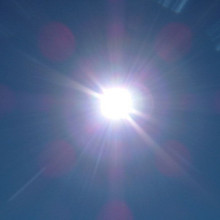
41:47 - The Sun and Climate Change
The Sun and Climate Change
with Professor Terry Sloan
Some people argue that climate change is not due to CO2, but in fact due to changes in solar activity. This was supported by the suggestion that the sun could influence cloud cover. Professor Terry Sloan has looked into this relationship and thinks it's more complicated than that - in fact he not convinced that the proposed link is there at all.
Helen - Thanks for joining us. What is this theory that there could be a link between solar activity and cloud cover?
 Terry - A few years ago, I grew up in Denmark, observed that the satellite data on cloud cover decreased (that was about 1990). At the same time they observed cosmic ray intensity, galactic cosmic ray intensity also decreased. They saw this correlation between the two. They hypothesised that the ionisation from the cosmic rays was causing clouds. If this is true, since the cosmic ray rate is decreased over the years (over about 100 years or so) then we have less cloud cover now than we had 100 years ago. Therefore that allows more sunlight to come to the Earth to warm the Earth and cause the global warming. That was the hypothesis. This seemed to us to be of vast significance because it means that climate change is being caused by cosmic rays and not the carbon dioxide that the RPCC say. We thought we'd better try and check this.
Terry - A few years ago, I grew up in Denmark, observed that the satellite data on cloud cover decreased (that was about 1990). At the same time they observed cosmic ray intensity, galactic cosmic ray intensity also decreased. They saw this correlation between the two. They hypothesised that the ionisation from the cosmic rays was causing clouds. If this is true, since the cosmic ray rate is decreased over the years (over about 100 years or so) then we have less cloud cover now than we had 100 years ago. Therefore that allows more sunlight to come to the Earth to warm the Earth and cause the global warming. That was the hypothesis. This seemed to us to be of vast significance because it means that climate change is being caused by cosmic rays and not the carbon dioxide that the RPCC say. We thought we'd better try and check this.
Helen - How did you start looking at that? How did you go into detail?
Terry - Well one of the things we did was just mentioned a few minutes ago. The solar flare of 1989 and the one in 2003. Not only did this cause huge changes in the aurora but it spewed out a whole load of particles that interacted in the atmosphere and caused a big increase in the ionisation in the air.
Chris - Crucially did you see a big change in clouds?
Terry - No.
Chris - So that was the clincher then?
Terry - That was the first nail in the coffin. Then we looked at a couple of other things. Cosmic rays occasionally go through quite a big decrease over the period of a week. They're called Forbush decreases and we looked to see when these decreases happened that the cloud cover also decreases at the same time. Again we could find no correlation. That was the second thing we looked at.
Helen - So have you come to the point where you can say, no cloud cover isn't affected by solar activity to the extent that it's related to climate change or is it something we should still bear in mind when we're thinking about what it is that's changing the temperatures in the world around us?
Terry - We did a measurement of how much of the cloud cover could be caused by cosmic rays. Our answer came out. Then we did a statistical analysis to say how big could the effect be and we'd missed it. It came out to be about 20%. In other words, about 20% of the changes in cloud cover are caused by cosmic rays. That's an upper limit that we deduced.
Chris - If cosmic rays are having this effect, how are they having this effect? Could that change over time?
Terry - No. Can I interrupt you there? We didn't say cosmic rays are having this effect, we tried to check the effect that was seen by the Danish scientists. All the evidence that we looked at did not corroborate their hypothesis. It could be as high as 20% within the measurements that we made. It was compatible with zero.
Chris - So the bottom line here is that the efforts we're making to try and cut carbon dioxide are appropriate because that's our best contender for driving climate change at the moment.
Terry - Yes, that's correct. The Danish group which effectively had challenged the conclusions of the IPCC had no right to challenge the IPCC. That's the international panel on climate change.

46:23 - Surviving in a Sealed Car?
Surviving in a Sealed Car?
Dr Gisli Jenkins, University of Nottingham...
The easy answer to this question is that you will never run out of air. You will just exchange the breath that you breathe in with the breath that you breathe out.
I guess what the question alludes to is how long you have to survive in that box before you die.
What you are doing is you're exchanging ambient air with exhaled air, and the gaseous composition of the two airs is quite different. Ambient air has a CO2 concentration of about 0.5% and oxygen concentration of about 21%. Exhaled air has a CO2 concentration of about 5% and an oxygen concentration of about 13%, so what you'll do over time is you'll reduce the oxygen level.
The problem is not so much the reduction of oxygen but the increase in carbon dioxide. By the time that the carbon dioxide levels in the air that you breathe reach 15%, you'll effectively die.
Assuming the box is about 4 cubic metres, it would take about 16 hours or so. But you would actually start to feel ill and probably die a lot sooner than that. Actually it could be down to, sort of, five hours!
Why do sound recorders pick up electrical interference and radio stations?
We put this question to Chris Davis, from the Rutherford Appleton Laboratory:
That's very interesting. It all depends at what frequency their equipment's working at but the radio station's reflected off the Earth's ionosphere which is an electrified layer on the edge of space which is where the aurora interferes with. The ionosphere by night can reflect radio stations over large distances and during the day they're much more absorbed in the lower atmospheres. It sounds like, if they're going out around dawn it might just be around the time these radio stations are changing and they're picking up signals from a distance when they wouldn't normally expect to.
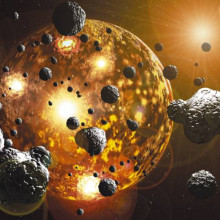
Could a distant habitable planet no longer really exist?
We put this question to Stuart Clarke, author of 'The Sun Kings":
Stuart - It's certainly possible if you're looking for planets in the whole galaxy you've got about 100,000 light years to imagine the size of telescope you'd have to build to actually see a planet 100,000 light years away is just so large. All the ones we'll look at will be only a few tens of light years away.
Chris - There is theoretically the possibility that we should pick up a star that turns out it should have some habitable planet around it but by the time we get to when we can see anything useful that star could have blown itself up.
Stuart - yes, the upside is that allows us to do cosmology because the farther we look into space the older the objects get we can do the archaeology of the heavens.
Chris - Are people looking at that?
Stuart - Exactly, that's how you do galaxy evolution. You just look for galaxies farther and farther away and know that's how they looked billions and billions of years ago.
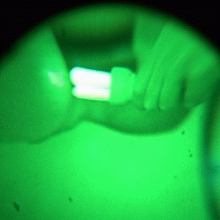










Comments
Add a comment